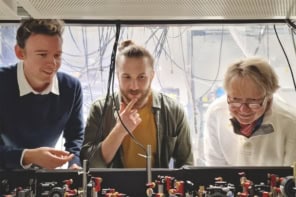A group of researchers in the US has developed a new kind of computing process that relies on the motion of molecules rather than the flow of electrons. Andreas Heinrich and colleagues at IBM’s Almaden Research Center in California have demonstrated how to make logic gates that use cascades of carbon monoxide molecules to transfer data. Devices made in this way have dimensions on the scale of nanometres, several orders of magnitude smaller than existing silicon-based components (A Heinrich et al Science to be published).
The density of components in silicon microchips has grown exponentially for more than four decades, but this progress is likely to slow down as devices approach the nanometre scale. Heinrich and colleagues have shown how to overcome this problem, in principle, by using a pair of low-temperature scanning tunnelling microscopes to arrange pairs of carbon monoxide molecules on a copper surface.
They moved a single carbon monoxide molecule alongside one of these pairs, so that the three molecules formed a chevron – the shape of an arrow head. However, this formation was unstable because it raised the energy of the system. The molecule at the tip of the chevron therefore hopped to the next pair of molecules, creating a new chevron, which in turn decayed. This process cascaded throughout the pairs of molecules, in a similar way to the motion of falling dominoes.
The IBM researchers used this principle to make an AND gate. They placed three rows of molecule pairs in a Y shape, with a single molecule at the point where the rows met. Two rows acted as inputs and the third acted as the output. If there is a cascade in both rows – i.e., if there is a “1” in both inputs – molecules will hop along the rows to form a chevron with the single molecule that is already at the point where the three rows meet. This chevron would then decay, generating a cascade (i.e. a signal) at the output. The researchers used a similar arrangement to make an OR gate.
Heinrich and co-workers were then able to join several AND and OR gates together to make more complicated logic devices. One such device, a three-input sorter, would have an area of about 50 microns squared if made using current technology, but it measured just 200 nanometers squared when constructed from molecular cascades.
Unfortunately the molecular cascade devices made by the IBM researchers were very slow and could only be used to perform a single operation. To re-use the devices the researchers had to place the molecules back into their original position using one of the scanning tunnelling microscopes. To be useful, molecular cascade computers would need an automatic mechanism that would reset some of the molecules and leave the others intact to act as data registers.



